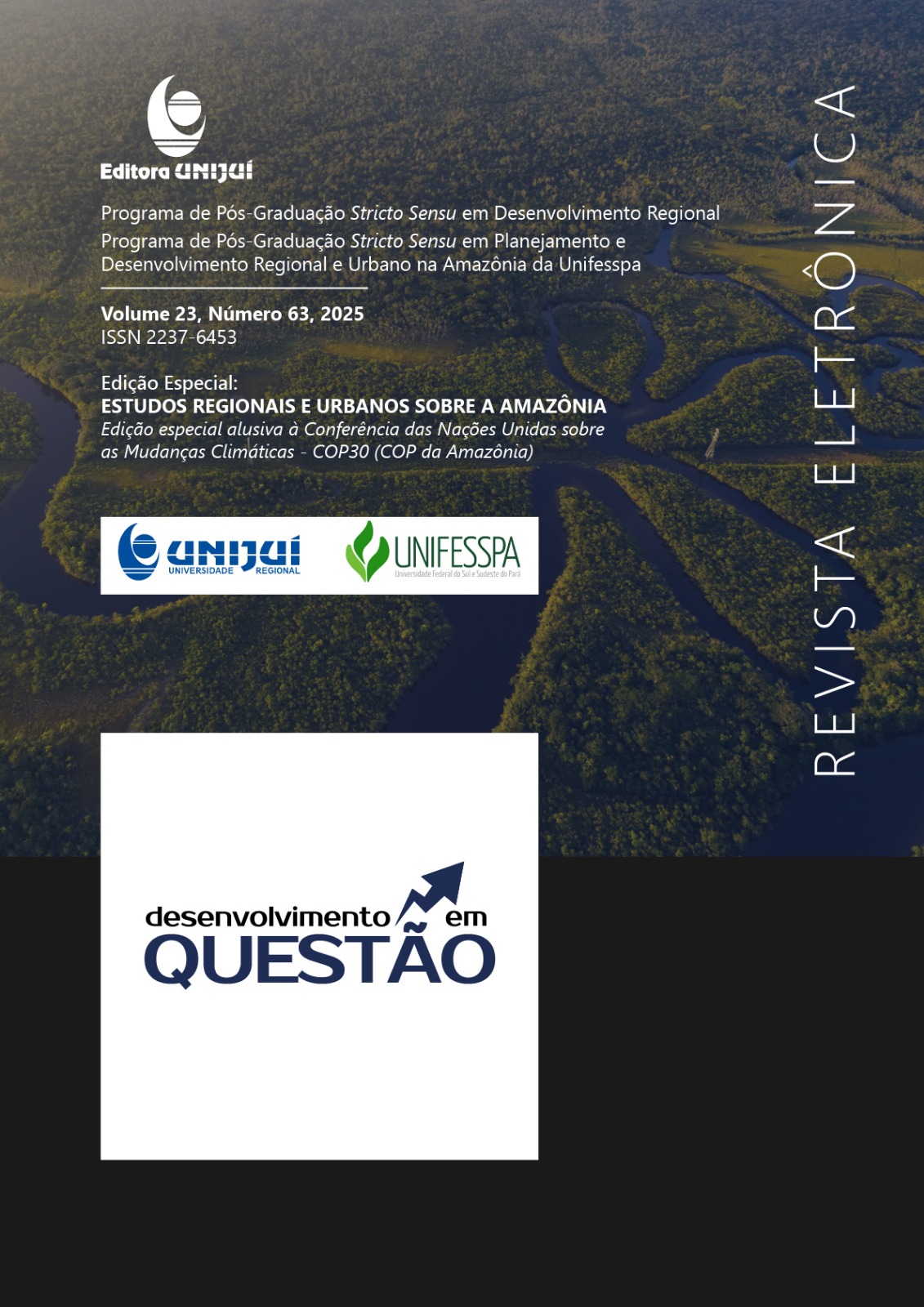Infrastructure and socio-productive systems: Challenges for integrated management in protected areas of the Lower Rio Negro Mosaic
DOI:
https://doi.org/10.21527/2237-6453.2025.63.16787Keywords:
Central Amazon, socio-economics, rural development, Conservation UnitsAbstract
Mosaics of Protected Areas emerge as an approach to strengthen the management of protected areas in Brazil, aiming for more effective governance through the integration of territories. We present the case of the Mosaic of the Lower Rio Negro (MBRN), in Amazonas, to reflect on the challenges of integrated management in Conservation Units with resident populations. Through structured questionnaires applied in 115 traditional communities of eight MBRN protected areas in 2022, we characterized productive practices and access to community infrastructure items. Later, we tested the hypothesis that larger traditional communities with more community infrastructure items present more productive practices. We identified that practices such as agriculture, fishing, crafts, and extractivism were homogeneous throughout the territory, while tourism activities, natural resource management, and livestock were developed in specific territories. No protected area can be characterized as excellent in relation to access to infrastructure, highlighting the precariousness of services in the region. We found that access to community infrastructure items enables the development of more productive practices, regardless of the size of the community. The territory of the MBRN revealed great heterogeneity in access to community infrastructure and socio-productive systems, which hinders the implementation of integrated management strategies. We highlight the significant challenge of jointly managing the territory to guarantee the quality of life and preserve the Amazon socio-biodiversity.
References
ABRAMOVAY R. et al. Chapter 30: The New Bioeconomy in the Amazon: Opportunities and Challenges for a Healthy Standing Forest and Flowing Rivers. In: NOBRE C. et al. (Eds). Amazon Assessment Report. United Nations Sustainable Development Solutions Network, New York, USA. 2021. Available at: https://www.theamazonwewant.org/spa-reports/. DOI: 10.55161/UGHK1968.
ALVES, J. D. G.; CÔRTES, J. C.; D’ANTONA, Á. O. Expansão da COVID - em Unidades de Conservação na Amazônia: implicações para a mobilidade espacial da população no Mosaico do Baixo Rio Negro. Terra Livre, [S. l.], [s.d.]. Available at: https://publicacoes.agb.org.br/terralivre/article/view/2933.
ALVES, J. D. G.; PEREIRA, H. C. Populações tradicionais e os efeitos das mudanças climáticas no Mosaico de Áreas Protegidas do Baixo Rio Negro (MBRN). In: SIMONETTI, S. R; PEREIRA, H. S.; BARBOSA, D. E. S (org) Autogestão e desenvolvimento territorial sustentável de áreas protegidas: diálogos, aprendizagens e resiliência. Manaus, AM: EDUA, 2023. p. 16 – 33.
BANDURA R.; MCKEOWN S. Sustainable Infrastructure in the Amazon Connecting Environmental Preservation with Governance, Security, and Economic Development. Center for Strategic and International Studies. Washington, USA. p.80, 2020. Available at: https://csis-website-prod.s3.amazonaws.com/s3fspublic/publication/201022_Bandura_Sustainable%20Infrastructure_Amazon
BARRETTO FILHO, H. T. et al. Chapter 31: Strengthening Governance and Management of Lands and Natural Resources: Protected Areas, Indigenous Lands, and Local Communities’ Territories. 2021. In: NOBRE C. et al. (ed). Amazon Assessment Report. United Nations Sustainable Development Solutions Network, New York, USA. 2021. Available at: https://www.theamazonwewant.org/spa-reports/. DOI: 10.55161/NQBA9165.
BITTENCOURT, F., POTIGUAR, M.; FERNANDES, T. Cadeia de valor do açaí: articulação e acesso aos benefícios. In: MARCOVITCH, J.; VAL, A. L. Bioeconomia para quem? Bases para um desenvolvimento sustentável na Amazônia. São Paulo, Com-Arte, 387p. 2024.
CAMPOS-SILVA, J. V. et al. Sustainable-Use Protected Areas Catalyze Enhanced Livelihoods in Rural Amazonia. Proceedings of the National Academy of Sciences, v. 118, n 40. 2021. https://doi.org/10.1073/pnas.2105480118.
COOK, P. Infrastructure, rural electrification and development. Energy for Sustainable Development, v.15, p. 304-313. 2011.
CÔRTES, J. C.; ALVES, J. D. G.; D'ANTONA, A. O. Rede urbana na Amazônia e vulnerabilidades de populações tradicionais: desigualdades no contexto da gestão de áreas protegidas. In: Anais do X Congreso da Asociación Latinoamericana de Población (ALAP) Valparíso, Chile, 2022.
D'ANTONA, A. O. Conservação ambiental, mobilidade espacial e condições de vida de populações tradicionais em áreas protegidas: por modelos de acesso à saúde adequados ao quadro amazônico. Cadernos de Saúde Pública, v. 39, p. 1-6, 2023.
D’ANTONA, A. O., ALVES, J. D. G. The use of computer tablets in sociodemographic surveys under unfavorable field conditions - an application in land use and cover change studies in the Amazon. International Journal of Social Research Methodology, v. 1, p. 1-11, 2023.
DA-GLORIA, P.; PIPERATA, B. A. Modos de vida dos ribeirinhos da Amazônia sob uma abordagem biocultural. Ciência e Cultura, São Paulo, v. 71, n. 2, p. 45-51. 2019. Available at: http://cienciaecultura.bvs.br/scielo.php?script=sci_arttext&pid=S0009-67252019000200014&lng=en&nrm=iso.
DIDIER, K. et al. O Mosaico do Baixo Rio Negro e o seu Plano de Monitoramento. In: DIDIER K, ESTUPIÑÁN G.M.B. (ed.). Plano de Monitoramento do Mosaico de Áreas Protegidas do Baixo Rio Negro, Amazonas, Brasil. Wildlife Conservation Society (WCS Brasil) e o Conselho do Mosaico do Baixo Rio Negro, Manaus, Amazonas, Brasil. 2017. p. 5 – 35.
GOVERNO DO ESTADO DO AMAZONAS. Decreto n° 22.747, de 26 de junho de 2002. Regulamenta a pesca esportiva, recreativa e de subsistência no Estado do Amazonas. 2002.
GUALBERTO, C. G.; ESTUPIÑAN, G. M. B. Cap 5 - Plano de Monitoramento da Pesca do Mosaico do Baixo Rio Negro, Amazonas, Brasil. In DIDIER, K.; ESTUPIÑÁN, G. M. B. (Eds.) Plano de Monitoramento do Mosaico de Áreas Protegidas do Baixo Rio Negro, Amazonas, Brasil. Wildlife Conservation Society (WCS Brasil) e o Conselho do Mosaico do Baixo Rio Negro, Manaus, Amazonas, Brasil. 2017. p. 121 – 146.
GUINATO, R. B. et al. Caracterização socioeconômica de comunidades tradicionais do Mosaico do Baixo Rio Negro. Terra Livre, São Paulo, a. 38, v.2, n. 61, p. 639-682. 2023.
GUINATO, R. B.; LOUREIRO, L. F.; CORRÊA, D. S. S. Impactos da ausência de infraestrutura para o desenvolvimento socioeconômico da Amazônia. InterAção, [S. l.], v. 16, n. 1, p. e90039, 2025. DOI: 10.5902/2357797590039.
GURDAK, D. J. et al. Diversity in reproductive traits of arapaima (Arapaima spp., Müller, 1843) in Amazonian várzea floodplains: Conservation implications. Aquatic Conservation: Marine and Freshwater Ecosystem, e. 29, p. 245-257. 2019. DOI: https://doi.org/10.1002/aqc.3030
HANUSCH, M. A Balancing Act for Brazil’s Amazonian States: An Economic Memorandum. International Development in Focus. Washington, DC: World Bank. 2023. DOI:10.1596/978-1-4648-1909-4.
IBGE. Amazônia Legal. 2024. Disponível em: https://www.ibge.gov.br/geociencias/cartas-e-mapas/mapas-regionais/15819-amazonia-legal.html. Acesso em: 9 set. 2025.
IWAMOTO, H, M.; LEAL, V. A.; CANÇADO, A. C. Jalapão Mosaic: Perspectives and Challenges for Implementing the Sustainable Development Goals (SDGs). Sociedade & Natureza, v. 36, p. 1-13. 2024. DOI: 10.14393/SN-v36-2024-70921
LEVIS, C. et al. Help restore Brazil’s governance of globally important ecosystem services. Nature Ecology & Evolution, v.4, n.2, p.172–173. 2020. https://doi.org/10.1038/s41559-019-1093-x.
LIMA, D.; POZZOBON, J. Amazônia socioambiental: sustentabilidade ecológica e diversidade social. Estudos Avançados, São Paulo, Brasil, v. 19, n. 54, p. 45–76, 2005. Available at: https://www.revistas.usp.br/eav/article/view/10070.
MINISTÉRIO DO MEIO AMBIENTE - Portaria Nº 483, De 14 De Dezembro De 2010. Reconhece o Mosaico do Baixo Rio Negro. Available at: <https://antigo.mma.gov.br/estruturas/240/_arquivos/portaria_baixo_rio_negro_240.pdf>
MINISTÉRIO DO MEIO AMBIENTE - Instituto Chico Mendes de Conservação da Biodiversidade. Instrução Normativa Nº 16, de 4 de Agosto de 2011. Regula, no âmbito do Instituto Chico Mendes, as diretrizes e os procedimentos administrativos para a aprovação do Plano de Manejo Florestal Sustentável (PMFS) comunitário para exploração de recursos madeireiros no interior de Reserva Extrativista, Reserva de Desenvolvimento Sustentável e Floresta Nacional. 2011.
MOURA, E. A. F. et al. (Orgs.) Sociodemografia da Reserva de Desenvolvimento Sustentável Mamirauá: 2001- 2011. Tefé: Instituto de Desenvolvimento Sustentável Mamirauá; Belém: IDSM; NAEA; 2016.
NASCIMENTO, A. C. S. et al. (Orgs.) Sociobiodiversidade Da Reserva De Desenvolvimento Sustentável Amanã (1998-2018): 20 Anos De Pesquisas. Tefé/Am: IDSM. v.1. 2019. Available at: https://www.mamiraua.org.br/documentos/1a8fb464341de84156fef2c2eb778be3.pdf
PERALTA, N.; LIMA, D. M. A Comprehensive Overview of The Domestic Economy in Mamirauá and Amanã in 2010. Uakari, v.9, n.2, p. 33-62. 2013. https://Doi.Org/10.31420/Uakari.V9i2.155.
PEREIRA, H. C. et al. Migração rural-urbana por demanda educacional no Médio Solimões, Amazonas. Revista brasileira de educação, v. 27, p. 1-26, 2022.
SANTOS, D. Fatos da Amazônia - Socioeconomia. Projeto Amazônia 2030. p.107. 2020. Available at: https: www.amazonia2030.org.br
SANTOS, D.; SANTOS, M. L.; VERÍSSIMO, B. Fatos da Amazônia - Socioeconomia. Projeto Amazônia 2030. 2022. Available at: https://amazonia2030.org.br/fatos-da-amazonia-socioeconomia/
SILVA, A. T. R. Áreas Protegidas, populações tradicionais da Amazônia e novos arranjos conservacionistas. Revista Brasileira de Ciências Sociais, v. 34, n. 99. 2019. DOI: 10.1590/349905/2019.
SNUC - Sistema Nacional de Unidades de Conservação. Brasil, Lei no 9.985, de 18 de julho de 2000 - institui o Sistema Nacional de Unidades de Conservação da Natureza e dá outras providências. 2000.
SOARES, L. M. O.; MIRANDA, G. E. C.; MOURÃO, J. S. An empirical analysis of the management model practiced in Protected Areas of Sustainable Use. Sociedade & Natureza, v. 32, p. 472-483. 2020.
TURLEY, L.; UZSOKI, D. Financing rural infrastructure: priorities and pathways for ending hunger. The International Institute for Sustainable Development. 2018.
UMA CONCERTAÇÃO PELA AMAZÔNIA (Org.). Bioeconomia: a evolução do debate e repercussões nas Amazônias. São Paulo: Arapyaú, Cadernos da Concertação, n.2. 2023.
UNEP-WCMC, IUCN. Protected Planet Report 2020. Cambridge and Gland, 2021. Available at: https://www. unep.org/pt-br/resources/relatorio-planeta-protegido-2020.
VILLAR, P. F. et al. PROTOCOL: The effects of agricultural output market access interventions on agricultural, socio‐economic and food and nutrition security outcomes in low‐ and middle‐income countries: A systematic review. Campbell Systematic Reviews, v.19, e.1348. 2023. DOI: https://doi.org/10.1002/cl2.1
Downloads
Published
How to Cite
Issue
Section
License
Copyright (c) 2025 Rayssa Bernardi Guinato, José Diego Gobbo Alves, Ana Claudeise Silva do Nascimento, Alvaro de Oliveira D'Antona

This work is licensed under a Creative Commons Attribution 4.0 International License.
By publishing in Revista Desenvolvimento em Questão, authors agree to the following terms:
All works are published under the Creative Commons Attribution 4.0 International License (CC BY 4.0), which allows:
Sharing — to copy and redistribute the material in any medium or format;
Adaptation — to remix, transform, and build upon the material for any purpose, even commercially.
These permissions are irrevocable, provided that the following terms are respected:
Attribution — authors must be properly credited, a link to the license must be provided, and any changes made must be indicated.
No additional restrictions — no legal or technological measures may be applied that legally restrict others from doing anything the license permits.
Notices:
The license does not apply to elements that are in the public domain or covered by legal exceptions.
The license does not grant all necessary rights for specific uses (e.g., image rights, privacy, or moral rights).
The journal is not responsible for the opinions expressed in the articles, which are the sole responsibility of the authors. The Editor, with the support of the Editorial Board, reserves the right to suggest or request modifications when necessary.
Only original scientific articles presenting research results of interest that have not been previously published or simultaneously submitted to another journal with the same purpose will be accepted.
Mentions of trademarks or specific products are intended solely for identification purposes and do not imply any promotional relationship by the authors or the journal.
License Agreement (for articles published from 2025 onward): Authors retain the copyright to their article and grant Revista Desenvolvimento em Questão the right of first publication.











